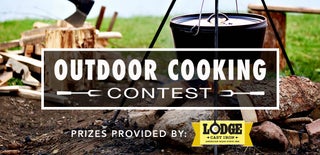Introduction: Stone Oven -How to Build / Use Primitive Cooking Technology-
Whether in modern or primitive times, the cooking gear needed to grill or bake a hearty meal can be appreciated by all. This Instructable is an introduction to a more basic cooking technology, from a time when electric/gas stoves and ovens had not yet existed. As a history lesson or possible backyard project, this stone oven is a handy piece of knowledge worth consideration.
Check out the videos at the end of this Instructable on how to build, as well as use, this stone oven.
Step 1: The Perfect Location
Before beginning this project, it is important to consider the materials needed as well as a reasonable build location. The stone oven will be made of stone (surprise). The type pictured is a Texas sandstone. You will also want to make sure that the placement of your primitive kitchen appliance (stone oven) is appropriate for its use i.e. build this in a spot that is suited for cooking.
Step 2: Stacking Rocks (Fire Box)
Stacking rocks in this build is a time consuming, but necessary skill to master. For those of us from the Tetris generation, the interlocking placement of stones to build the walls of the oven can be a nostalgic trip down memory lane. Good luck to everyone else.
An abundance of rocks in a variety of sizes and shapes need to be at hand before beginning on the foundation. If possible, use the largest stones at the base as this part of the three walls will be supporting most of the weight. Fit the stones together as closely as possible when stacking. If necessary, natural clay or soil can be used as mortar and/or filler.
The length of your walls is largely dependent upon the size of a ledge and capstone. The larger your available stones, the longer your walls. The height of your walls up until the ledge stone is placed should measure between 8 to 16 inches.
Step 3: The Ledge Stone
Once your foundation walls have been built to the desired uniform height, an important piece called the ledge stone should be placed. The ledge stone acts as a barrier between the flames of the fire and the oven compartment where food is cooked. Large and flat, the ledge stone should extend and overlap from wall to wall width-wise, while leaving a +4 inch gap between it and the back wall.
Hard to reach sections of the wall beneath and behind the ledge stone should be completed, as further building will make these areas largely inaccessible.
Step 4: Rock Stacking (Oven Compartment)
The walls of this stone oven must be stacked higher and extended on the ledge stone in order to create the oven compartment. These walls will not only direct and hold in the heat of the oven, but must support the weight of a capstone. A height that allows for a functional oven compartment is at least 5+ inches, but can vary depending upon your needs.
Step 5: The Cap Stone
The final big step in this oven build is the placement of the capstone. The capstone is a second large, flat rock that will extend and overlap all three walls becoming the top of the structure and providing a roof for the oven compartment.
Once this stone has been placed and settled, the detail work of sealing up cracks and fixing cosmetic issues can be accomplished. Once you have it just the way you want it, a fire and meal should follow shortly after.
Step 6: Fire It Up!
To get this stone oven going, a fire will need to be placed in the fire box opening. Once the flames get going, smoke and heat should be naturally pulled back up and through the oven compartment (draft).
Each stone oven is unique and will take some getting used to. Figuring out the size of fire necessary to cook different meals will vary based upon the natural variations in construction. You'll probably be pleased to find how stable and uniform the oven temperature can be due to the rock's natural heat retention.
Step 7: Cooking and Accessories
Just about any food that you can imagine cooking in a modern oven may be prepared similarly using this primitive stone oven. Fish and breads (as pictured above) are just a taste of what is possible.
Note: A small wooden tray is visible beneath both bread and fish. This tray allows for airflow beneath the food,, as well as above, for more even cooking.
For the industrious type, further modifications and accessories may be fashioned to allow an even greater range of culinary possibilities. As an example, a tripod frame (as pictured above) positioned over the stone oven can act as a drying rack and/or cold smoking system in order to preserve and infuse a variety of foods.
Step 8: Watch These Videos to See How It's Done
Not a step, but if a picture is worth a thousand words, then a video ought to be worth at least a thousand pictures. Click on the video above to see how it's done. Check out my YouTube Channel to see more videos like this one: Bob Hansler https://www.youtube.com/user/horsebackbob

Third Prize in the
Outside Contest 2017

Runner Up in the
Outdoor Structures

Second Prize in the
Outdoor Cooking Contest 2017













